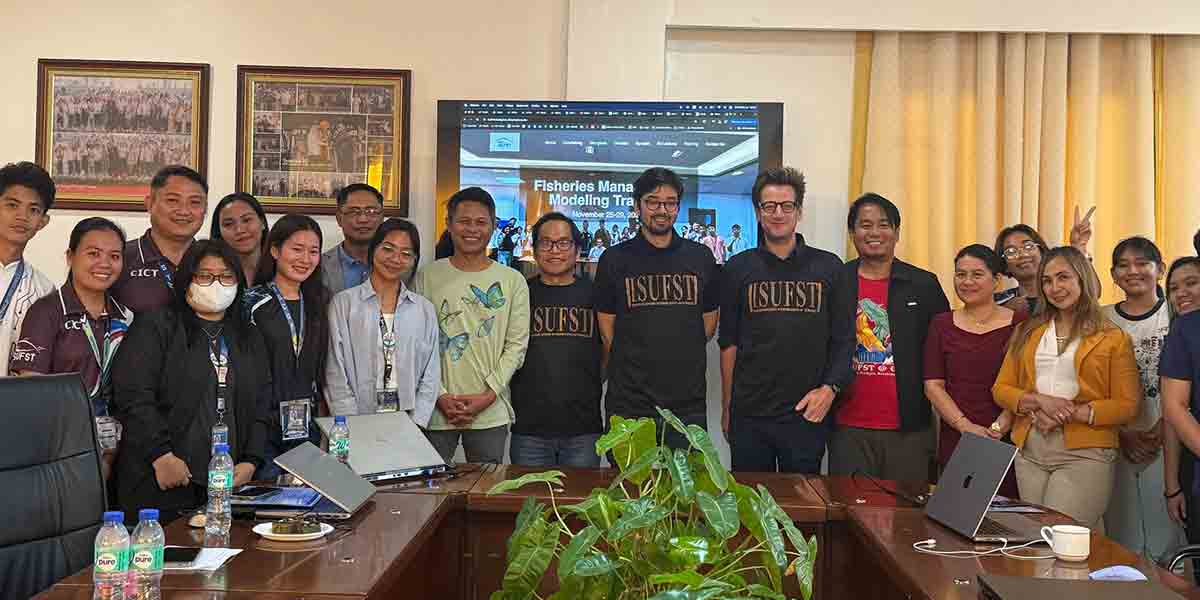
Hog raisers of Sibalom, Antique, are turning the African Swine Fever (ASF) threats to their advantage.
When swine flu cases were reported in Luzon, they acted quickly to protect their multi-million industry, which serves as one of the leading income sources of the local farmers.
Stringent monitoring, surveillance, implementation of biosecurity measures, and info drive down to the community level were carried out to safeguard the town and the whole of Antique from the dreaded hog virus.
They countered the fear of ASF by understanding how it can be transmitted and improving their adoption of recommended hog farming technologies and practices to amplify their swine production.
The collective efforts of the Municipal Agriculture Office and the Sibalom Livestock and Poultry Raisers Association (SILPRA) in preventing the ASF entry helped maintain the municipality’s green zone status up to the present.
SILPRA became a legitimate group on March 25, 2019, upon registering with the Department of Labor and Employment (DOLE). With a little over 100 initial members, SILPRA explored means to make strides in the marketing and upgrading breeder stocks for improved productivity and income.

Association president Elma T. Peña relayed that their primary intention was to resolve the problems on the falling live weight prices of hogs amid the uncontrollable increase in the costs of commercial feeds and pork meat in the local market.
“Farmers complained about the very low farm gate costs of their swine, which range from P75 to P80 per kilogram in 2017 and 2018. They were even discouraged from pushing through their hog-raising enterprises because of the lowering net income and profitability due to high input expenses. Sadly, the middlemen are gaining more income than the hog raisers,” said Peña, who initiated the forming of SILPRA through a series of consultations with the farmers.
Sibalom, as one of the largest towns in Antique, has a high inventory of hogs, although it is primarily notable for palay and corn production.
Before the pandemic, Sibalom raisers supplied at least 500 hogs weekly to Boracay Island in Malay, Aklan, but since the global health crisis has impacted even the tourism industry unprecedentedly, Antique farmers were clueless on where and how to sell their surplus produce.
This challenge prompted Municipal Agriculturist Albert G. Estoya to reactivate the SILPRA in 2020 to lead hogs’ consolidation, market matching, and trading.
“We looked for institutional buyers in Metro Manila. By establishing a direct market linkage, we increased the farm-gate price of hogs here in Sibalom from P80 to P105 per kilogram. It went up as high as P170 per kilogram when Antique hog raisers were encouraged by the DA to fill in the demand and shortage of pork meat supply in Metro Manila and Luzon as they were immensely affected by ASF outbreaks,” Estoya said.

SILPRA had initially shipped out 80 heads of swine to a direct buyer in Bulacan in July 2020 despite the strict implementation of the Enhanced Community Quarantine in an effort to slow down the COVID-19 spread. They successfully closed deals with at least six individuals and institutional buyers in Luzon, thus gaining more members from Sibalom, San Remigio, Belison, Anini-y, Tobias Fornier, Patnongon, Laua-an, San Jose, Valderrama, Bugasong, and Tibiao.
To broaden the SILPRA’s capacity in buying hogs of the local farmers in Sibalom and in nearby municipalities in Antique, the DA-Agribusiness and Marketing Assistance Division provided them a P500,000.00 trading capital and a hauling truck under the Kadiwa ni Ani at Kita Financial Grant Assistance Program.
The funds provided to the association helped them sustain the weekly shipment of at least 5,000 hogs to Metro Manila and other areas in Luzon. DA, LGU Sibalom, and Provincial agriculture and veterinary offices were instrumental in addressing the various constraints the raisers face as they pursue their consolidation and marketing activities despite the threats of the ASF and the restrictions due to the pandemic.
Peña deemed that having an established market for hogs outside the region prodded more farmers and even returning Overseas Filipino Workers (OFWs) who lost their jobs abroad due to the ongoing crisis to venture into hog raising. SILPRA members had also swiftly grown to almost 500.
With complementing interventions from the DA, the Sibalom Municipal Agriculture Office brought off activities that upgraded the farm animals in the municipality. “We keep on encouraging our members to ensure the quality of breeds that they are producing so we can obtain a premium price for our reared animals that we consolidate in the Livestock Oksyon Market (LOM) before we ship them to Metro Manila,” Peña said.
SILPRA manages the weekly operation of Sibalom LOM, a marketing facility constructed in 1978 by the DA-Bureau of Animal Industry (BAI). The facility, serving as the consolidation and trading venue for livestock and poultry animals, underwent a major revamp in 2013 with funding support from the Japan 2KR Project, DA, and the Local Government Unit of Sibalom.
“Dahil moderno na, ang Sibalom Livestock Oksyon Market ay mayroon ng loading at unloading rump na pwedeng gamitin ng kahit maliit o malaking trucks. Hindi na kailangan bumaba ang mga hayop pa papuntang kilohan o pabalik sa sasakyan. Meron na ding dalawang digital weighing scale, malaking istruktura na nagsisilbing pasilongan ng mga hayop, may matibay na bakod, palikuran, kumpletong water at lighting facilities, at IT component,” Peña shared.
Seeing the vast opportunities embedded in the hog sector, the Local Government Unit of Sibalom likewise extended assistance to swine raisers by providing a funding counterpart to the P7.5 million worth of a Feed Mill Project DA-BAI in Brgy. Igdalquit.
The feed mill facility, which is diesel and electrically driven, can mill up to eight tons of yellow corn per day. The project includes the construction of a warehouse, and the provision of a pneumatic hammer mill, horizontal feed mixer, micromixer, storage bin, flat conveyor, bucket elevator, weighing bucket, sack sealer, weighing scale, solar perimeter, and warehouse lights.
Not only the livestock and poultry raisers of the municipality can benefit from the processing facility since it will also be advantageous to corn farmers who are only earning P10 per kilogram of fresh yellow corn when they sell their produce to private millers.
“We have already started the operation of the feed mill. As what we have targeted, we are now buying the yellow corn from the local farmers at P18 per kilogram at 14 percent moisture content,” Estoya added.
Considering the boundless gains that the local farmers can acquire from the feed mill facility, Estoya is pushing for the expansion of yellow corn production areas in Sibalom and adjacent towns beginning this year. He had already lobbied for funding resources from the municipal government to buy the harvests of local corn growers and boost the yellow corn production by complementing the free seeds distributed by the DA Corn Program.
On top of providing a guaranteed market for corn growers, the facility will eventually lower the feed expenses and increase the net income of hog raisers in Sibalom. The processing project can potentially spell progress in the hog sector in Antique as more and more farmers will engage in the backyard and commercial swine production with declined prices of feed requirements.
Notwithstanding the ups and downs in hogs’ prevailing farm gate prices, SILPRA members emphasize several measures to protect their livelihood from ASF. They strictly enforced thorough cleaning and disinfection of their farms, consolidation area, and trucking vehicles to eliminate all possible ways of ASF occurrence. They are also grateful for the steadfast support and interventions rendered by the Provincial Veterinary Office to prevent ASF from entering and spreading to the province.
Remaining as one of the green zone towns nationwide, Sibalom, through the SILPRA, became a recipient of a hog multiplier farm project amounting to P1 million. “It is now on the bidding process. Soon enough, this will be another opportunity for our association to keep on progressing. We are grateful for being selected as a beneficiary of this swine breeder farm project for hog production and fattening,” shared Peña.
As part of the government’s attempt to revitalize the country’s hog industry, SILPRA will be receiving breeder stocks, materials for housing and fencing, drugs, biologics, and other relevant equipment in hog raising.
For Peña, integrating a clustering approach in implementing the DA project, such as the hog multiplier farm, will help ensure that the government resources yield positive outcomes. Target supply for breeder stocks and pork meat will be met as farmers will efficiently oversee and ensure the project’s success.
“We support the government’s call for clustering and consolidation. It will be convenient for us to meet the expected volume of hogs that we trade every week when we consolidate the hogs of our farmers. We can also save on logistic expenses and avoid inconvenience in our shipment,” she explained.
The Municipal Agriculture Office of Sibalom is also eyeing a clustering system in converting their arable lands to grow yellow corn, sorghum, and cassava as raw materials for feed formulation. Boosting the production of these crops will optimize the utilization of the feed mill facility intended to lessen the feed expenses of poultry and livestock farmers and generate a sure market for corn growers.
In a Biyaheng Bukid sortie in Hamtic, Antique, last 2017, Peña pleaded for a village-type feed mill facility to remedy the long-standing concern of hog farmers on the price of feed inputs. But fortunately, the government constructed a larger feed mill with improved capacity.
Furthermore, the clustering and consolidation ways will facilitate speedy and smooth implementation of DA assistance in Sibalom, leading the way to develop technology-adaptive, resilient, and market-driven hog raisers despite the threats of COVID-19 and ASF. Breaking new grounds for development, the SILPRA will soon take over the total management of the feed mill facility alongside their prime function of ensuring regular shipment of hogs outside the island. (Story by Sheila Mae H. Toreno/ Photos by Jerem V. De Guzman/DA-RAFIS-6)




















